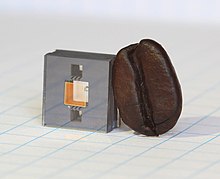
A laser is a device that emits light through a process of optical amplification based on the stimulated emission of electromagnetic radiation. The word laser is an anacronym that originated as an acronym for light amplification by stimulated emission of radiation. The first laser was built in 1960 by Theodore Maiman at Hughes Research Laboratories, based on theoretical work by Charles H. Townes and Arthur Leonard Schawlow.
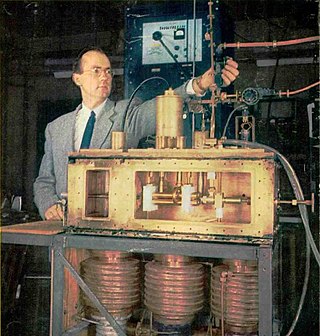
A maser is a device that produces coherent electromagnetic waves (microwaves), through amplification by stimulated emission. The term is an acronym for microwave amplification by stimulated emission of radiation. The first maser was built by Charles H. Townes, James P. Gordon, and Herbert J. Zeiger at Columbia University in 1953. Townes, Nikolay Basov and Alexander Prokhorov were awarded the 1964 Nobel Prize in Physics for theoretical work leading to the maser. Masers are also used as the timekeeping device in atomic clocks, and as extremely low-noise microwave amplifiers in radio telescopes and deep-space spacecraft communication ground stations.

Microwave is a form of electromagnetic radiation with wavelengths ranging from about 30 centimeters to one millimeter corresponding to frequencies between 1 GHz and 300 GHz respectively. Different sources define different frequency ranges as microwaves; the above broad definition includes UHF, SHF and EHF bands. A more common definition in radio-frequency engineering is the range between 1 and 100 GHz. In all cases, microwaves include the entire SHF band at minimum. Frequencies in the microwave range are often referred to by their IEEE radar band designations: S, C, X, Ku, K, or Ka band, or by similar NATO or EU designations.

The second is the unit of time in the International System of Units (SI), historically defined as 1⁄86400 of a day – this factor derived from the division of the day first into 24 hours, then to 60 minutes and finally to 60 seconds each.

A rubidium standard or rubidium atomic clock is a frequency standard in which a specified hyperfine transition of electrons in rubidium-87 atoms is used to control the output frequency.
The Primary Atomic Reference Clock in Space or PARCS was an atomic-clock mission scheduled to fly on the International Space Station (ISS) in 2008, but cancelled to make way for the Vision for Space Exploration. The mission, to have been funded by NASA, involved a laser-cooled caesium atomic clock, and a time-transfer system using Global Positioning System (GPS) satellites. PARCS was to fly concurrently with the Superconducting Microwave Oscillator (SUMO) a different type of clock that was to be compared against the PARCS clock to test certain theories. The objectives of the mission were to have been:
Louis Essen OBE FRS(6 September 1908 – 24 August 1997) was an English physicist whose most notable achievements were in the precise measurement of time and the determination of the speed of light. He was a critic of Albert Einstein's theory of relativity, particularly as it related to time dilation.

A real-time clock (RTC) is an electronic device that measures the passage of time.
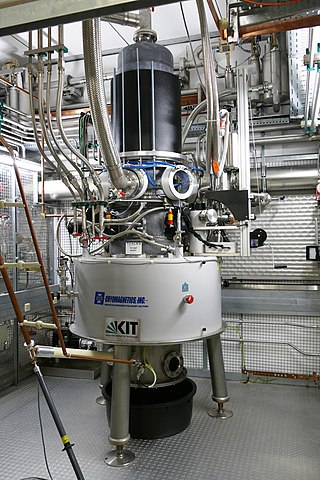
A gyrotron is a class of high-power linear-beam vacuum tubes that generates millimeter-wave electromagnetic waves by the cyclotron resonance of electrons in a strong magnetic field. Output frequencies range from about 20 to 527 GHz, covering wavelengths from microwave to the edge of the terahertz gap. Typical output powers range from tens of kilowatts to 1–2 megawatts. Gyrotrons can be designed for pulsed or continuous operation. The gyrotron was invented by Soviet scientists at NIRFI, based in Nizhny Novgorod, Russia.

A crystal oven is a temperature-controlled chamber used to maintain the quartz crystal in electronic crystal oscillators at a constant temperature, in order to prevent changes in the frequency due to variations in ambient temperature. An oscillator of this type is known as an oven-controlled crystal oscillator This type of oscillator achieves the highest frequency stability possible with a crystal. They are typically used to control the frequency of radio transmitters, cellular base stations, military communications equipment, and for precision frequency measurement.

NIST-F1 is a cesium fountain clock, a type of atomic clock, in the National Institute of Standards and Technology (NIST) in Boulder, Colorado, and serves as the United States' primary time and frequency standard. The clock took less than four years to test and build, and was developed by Steve Jefferts and Dawn Meekhof of the Time and Frequency Division of NIST's Physical Measurement Laboratory.
Nanophotonics or nano-optics is the study of the behavior of light on the nanometer scale, and of the interaction of nanometer-scale objects with light. It is a branch of optics, optical engineering, electrical engineering, and nanotechnology. It often involves dielectric structures such as nanoantennas, or metallic components, which can transport and focus light via surface plasmon polaritons.
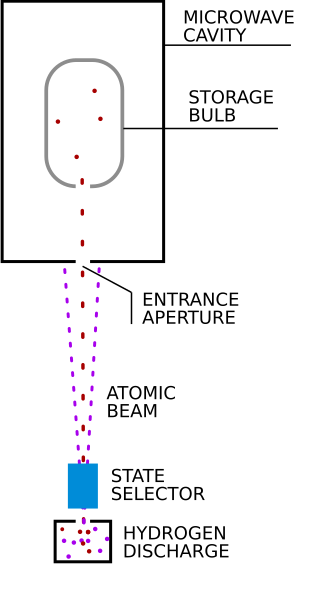
A hydrogen maser, also known as hydrogen frequency standard, is a specific type of maser that uses the intrinsic properties of the hydrogen atom to serve as a precision frequency reference.
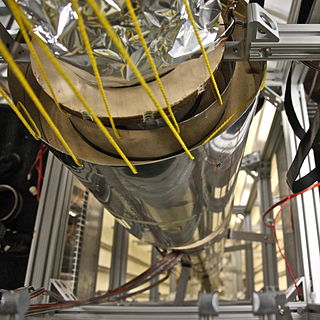
An atomic fountain is a cloud of atoms that is tossed upwards in the Earth's gravitational field by lasers. If it were visible, it would resemble the water in a fountain. While in free-fall, the atoms are measured to set the frequency of an atomic clock.
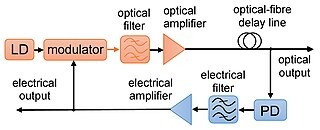
In optoelectronics, an opto-electronic oscillator (OEO) is a circuit that produces a repetitive electronic sine wave and/or modulated optical continuous wave signals.

An atomic clock is a clock that measures time by monitoring the resonant frequency of atoms. It is based on atoms having different energy levels. Electron states in an atom are associated with different energy levels, and in transitions between such states they interact with a very specific frequency of electromagnetic radiation. This phenomenon serves as the basis for the International System of Units' (SI) definition of a second:
The second, symbol s, is the SI unit of time. It is defined by taking the fixed numerical value of the caesium frequency, , the unperturbed ground-state hyperfine transition frequency of the caesium 133 atom, to be 9192631770 when expressed in the unit Hz, which is equal to s−1.
A quantum clock is a type of atomic clock with laser cooled single ions confined together in an electromagnetic ion trap. Developed in 2010 by physicists at the U.S. National Institute of Standards and Technology, the clock was 37 times more precise than the then-existing international standard. The quantum logic clock is based on an aluminium spectroscopy ion with a logic atom.
Symmetricom, Inc. develops, manufactures, and supplies timekeeping technology to customers in industry and government worldwide that require extremely precise synchronization. Symmetricom products supported precise timing standards, including GPS-based timing, IEEE 1588 (PTP), Network Time Protocol (NTP), Synchronous Ethernet and Data Over Cable Service Interface Specifications (DOCSIS®) timing.
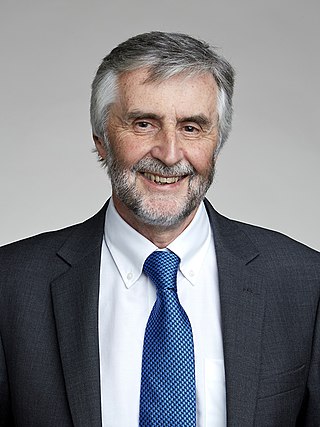
Patrick Gill is a Senior NPL Fellow in Time & Frequency at the National Physical Laboratory (NPL) in the UK.
The Dick effect is an important limitation to frequency stability for modern atomic clocks such as atomic fountains and optical lattice clocks. It is an aliasing effect: High frequency noise in a required local oscillator (LO) is aliased (heterodyned) to near zero frequency by a periodic interrogation process that locks the frequency of the LO to that of the atoms. The noise mimics and adds to the clock's inherent statistical instability, which is determined by the number of atoms or photons available. In so doing, the effect degrades the stability of the atomic clock and places new and stringent demands on LO performance.

